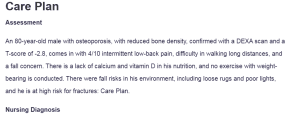Care Plan
Assessment
An 80-year-old male with osteoporosis, with reduced bone density, confirmed with a DEXA scan and a T-score of -2.8, comes in with 4/10 intermittent low-back pain, difficulty in walking long distances, and a fall concern. There is a lack of calcium and vitamin D in his nutrition, and no exercise with weight-bearing is conducted. There were fall risks in his environment, including loose rugs and poor lights, and he is at high risk for fractures: Care Plan.
Nursing Diagnosis
Risk for fractures secondary to osteoporosis, compromised bone density, and compromised balance as evidenced by old age, a DEXA scan with a T-score of -2.8, intermittent 4/10 rated back pain, difficulty in walking long distances, and fall danger in the living environment (Porter et al., 2023).
Broad Goal
Through nutrition, exercise, medication compliance, and fall prevention techniques, the client will strengthen bones, prevent fractures, and promote mobility. These interventions will improve bone health and quality of life.
SMART Outcomes
The client will have 1,200 mg of calcium and 800 IU of vitamin D daily for two weeks, with proper bone nutrition. There will be at least three balancing and weight-bearing exercise sessions a week for four weeks for increased muscle strength and stability. There will be correct compliance with osteoporosis therapy for one month. There will not be any falls or fractures in six months, and he will be safe and mobile.
Interventions and Rational
Providing nutritional information regarding foods rich in calcium and vitamin D, such as dairy, fish, and cereals, will build bones. Home fall risk assessments and adaptations, including grab rails and proper lighting, will maximize security (Campani et al., 2021). A personalized exercise routine with weight-bearing exercises like walking and yoga in a chair will develop bone and muscle strength.
Further, proper compliance with medication through educating the client regarding taking bisphosphonates appropriately will maximize efficacy (Ganesan et al., 2023). Regular monitoring through follow-ups and bone scans will track improvement and allow care planning adaptations.
Evaluation
Monitoring will be done regularly to ensure the client successfully meets his nutritional intake needs, stays with a proper exercise routine, adheres to medication regimens, and does not have fractures or falls, confirming the effectiveness of interventions.
References
Campani, D., Caristia, S., Amariglio, A., Piscone, S., Ferrara, L. I., Barisone, M., Bortoluzzi, S., Faggiano, F., Dal Molin, A., Silvia Zanetti, E., Caldara, C., Bellora, A., Grantini, L., Lombardi, A., Carimali, C., Miotto, M., Pregnolato, A., & Obbia, P. (2021). Home and environmental hazards modification for fall prevention among the elderly. Public Health Nursing, 38(3), 493–501. https://doi.org/10.1111/phn.12852
Ganesan, K., Bansal, P., Goyal, A., & Roane, D. (2023, July 3). Bisphosphonate. PubMed; StatPearls Publishing. https://www.ncbi.nlm.nih.gov/books/NBK470248/
Porter, J. L., Varacallo, M., & Castano, M. (2023, August 4). Osteoporosis. PubMed; StatPearls Publishing. https://www.ncbi.nlm.nih.gov/books/NBK568781/
ORDER A PLAGIARISM-FREE PAPER HERE
We’ll write everything from scratch
Question 
Create a Problem-based Care Plan for one of the following problems and bring to next class (10 points):
- Osteoporosis or Fracture
- COPD
- Stroke
- Fall Risk
- Risk for altered tissue integrity

Care Plan
Include broad goal, SMART outcomes, and enough interventions to reach the SMART outcomes. The interventions need to be specific to the elderly client in one of the clinical judgment activities discussed in class. 80 YEAR OLD MALE
